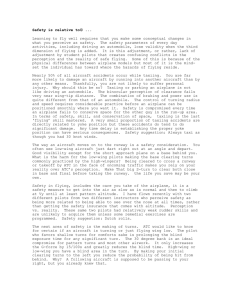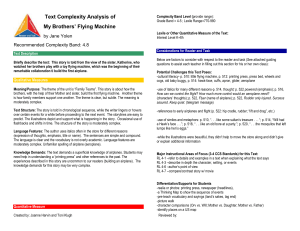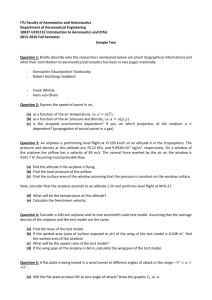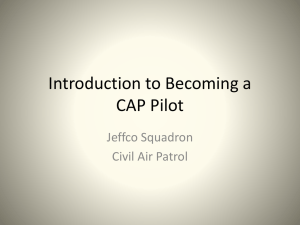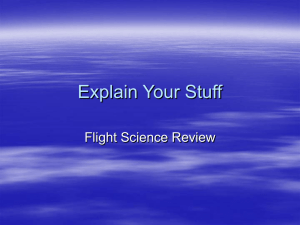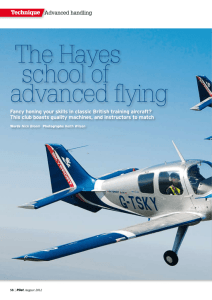SEE AND AVOID, by Dave McClurkin A pilot was conducting pattern
advertisement
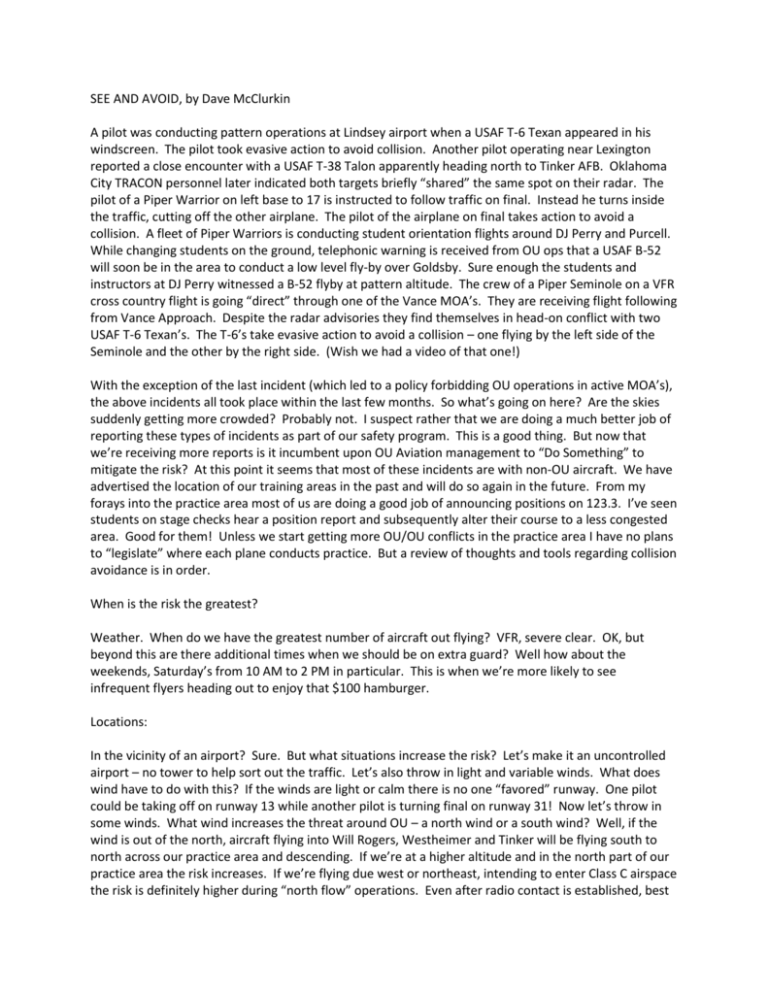
SEE AND AVOID, by Dave McClurkin A pilot was conducting pattern operations at Lindsey airport when a USAF T-6 Texan appeared in his windscreen. The pilot took evasive action to avoid collision. Another pilot operating near Lexington reported a close encounter with a USAF T-38 Talon apparently heading north to Tinker AFB. Oklahoma City TRACON personnel later indicated both targets briefly “shared” the same spot on their radar. The pilot of a Piper Warrior on left base to 17 is instructed to follow traffic on final. Instead he turns inside the traffic, cutting off the other airplane. The pilot of the airplane on final takes action to avoid a collision. A fleet of Piper Warriors is conducting student orientation flights around DJ Perry and Purcell. While changing students on the ground, telephonic warning is received from OU ops that a USAF B-52 will soon be in the area to conduct a low level fly-by over Goldsby. Sure enough the students and instructors at DJ Perry witnessed a B-52 flyby at pattern altitude. The crew of a Piper Seminole on a VFR cross country flight is going “direct” through one of the Vance MOA’s. They are receiving flight following from Vance Approach. Despite the radar advisories they find themselves in head-on conflict with two USAF T-6 Texan’s. The T-6’s take evasive action to avoid a collision – one flying by the left side of the Seminole and the other by the right side. (Wish we had a video of that one!) With the exception of the last incident (which led to a policy forbidding OU operations in active MOA’s), the above incidents all took place within the last few months. So what’s going on here? Are the skies suddenly getting more crowded? Probably not. I suspect rather that we are doing a much better job of reporting these types of incidents as part of our safety program. This is a good thing. But now that we’re receiving more reports is it incumbent upon OU Aviation management to “Do Something” to mitigate the risk? At this point it seems that most of these incidents are with non-OU aircraft. We have advertised the location of our training areas in the past and will do so again in the future. From my forays into the practice area most of us are doing a good job of announcing positions on 123.3. I’ve seen students on stage checks hear a position report and subsequently alter their course to a less congested area. Good for them! Unless we start getting more OU/OU conflicts in the practice area I have no plans to “legislate” where each plane conducts practice. But a review of thoughts and tools regarding collision avoidance is in order. When is the risk the greatest? Weather. When do we have the greatest number of aircraft out flying? VFR, severe clear. OK, but beyond this are there additional times when we should be on extra guard? Well how about the weekends, Saturday’s from 10 AM to 2 PM in particular. This is when we’re more likely to see infrequent flyers heading out to enjoy that $100 hamburger. Locations: In the vicinity of an airport? Sure. But what situations increase the risk? Let’s make it an uncontrolled airport – no tower to help sort out the traffic. Let’s also throw in light and variable winds. What does wind have to do with this? If the winds are light or calm there is no one “favored” runway. One pilot could be taking off on runway 13 while another pilot is turning final on runway 31! Now let’s throw in some winds. What wind increases the threat around OU – a north wind or a south wind? Well, if the wind is out of the north, aircraft flying into Will Rogers, Westheimer and Tinker will be flying south to north across our practice area and descending. If we’re at a higher altitude and in the north part of our practice area the risk increases. If we’re flying due west or northeast, intending to enter Class C airspace the risk is definitely higher during “north flow” operations. Even after radio contact is established, best to stay below Class C until the controller calls “radar contact” and knows for sure where you are in relation to other traffic. How often will the controller direct a significant heading change in a north flow situation compared to south flow conditions? I’m not saying we can let down our guard during south flow operations – but probably a good idea to add an extra layer of vigilance when the wind is from the north. In the vicinity of VOR’s? Yup, that’s what the book says. In these days of greater “GPS direct” navigation the risk here could be decreasing a bit, but believe it or not, not everybody has GPS. Cross-Country. There are dictated altitudes to fly for VFR and IFR traffic that lowers the risk of a head on collision. It works best for east/west bound traffic. How about north/south bound traffic? Airplane A is on a magnetic course of 005 degrees and correctly flying at an altitude of 5,500 feet. Airplane B is on a magnetic course of 175 degrees and correctly flying at an altitude of . . . 5,500 feet. Is the risk greater in this situation? Now let’s put them flying almost opposite directions down a victor airway? Cause for concern? Anybody else have any thoughts on locations and situations that increase collision risk? Send me an email. So what tools do we have to avoid becoming another airplane’s hood ornament? Big Sky, Small Airplanes. This may not be politically correct, but it’s true. This concept in my opinion by far provides the greatest mitigation of collision risk. OK, but we can do better than depend on low probabilities. Technology. Most of our new airplanes have TIS (Traffic Information Service). If you’re within 20 nautical miles or so of a TRACON, if the system is working and if the other aircraft has an operating transponder, traffic will be displayed on the GNS 430 by way of the TRACON through your Mode S transponder. It will display target location, direction of flight and altitude relative to your aircraft. It’s a great tool for traffic awareness in the practice area. Remember that updates come only every 5 – 10 seconds. In some situations (slow flight and steep turns) it will paint your own aircraft as traffic right on top of you. It’s less effective in a fast paced traffic pattern. We also have a few planes (King Air and Baron) with a better TCAS system which provides more instantaneous location of traffic. The Arrows, Cessna and Seneca do not have either system. The Human Eye. A wondrous device for perceiving the world – and remarkably inefficient for identifying traffic. Yet the eye is our first and last line of defense for traffic avoidance – See and Avoid! Most collision accident reports don’t fault the technology, they fault the pilot’s inability to see and avoid. I can go on and on about the limitations of the eye. Instead let’s talk about some things to enhance this tool. -- A clean windshield. We start out clean in the morning. Later in the day if the windshield is covered with bug strikes do you take the time to clean it off? Sure, a well positioned bug splat can be useful in lining up your aim point on landing, but it’s probably not worth the increased risk of obscuring traffic. -- Look outside! You should be looking outside (in VMC conditions) 80-90% of the time. Are you comfortable flying the aircraft by outside references? If not, your eyes will be glued to the instruments. If you’re flying one of the glass planes with all the eye candy you’re at even greater risk of being distracted by what’s going on inside the cockpit. Even the little airplane on the magenta line of the GNS 430 can be an overwhelming distraction. Yes, follow the prescribed scanning techniques: scan the horizon in ten degree segments, use offset viewing at night, realize that if an object’s angular position is not changing and growing bigger in the wind shield you’re on a collision course . . . blah, blah, blah. That’s all good, but 90% of the battle is making yourself look outside! Enjoy the view. Isn’t that why you’re learning to fly!? -- Clearing Turns. If I had a nickel for every time a student has started a maneuver and I have to ask, “What do we do before every maneuver?” I could probably by a Cirrus. I’ll chalk some of it up to stage check nervousness. But, where are your eyes when you’re doing the clearing turn? Are they inside looking at the instruments in order to execute a perfect 30-degree bank turn at constant altitude? Or are they outside looking for traffic. This gets back to being able to fly the airplane by outside references. -- Aircraft blind spots – mainly those annoying wings. Can you and do you adjust pitch and bank occasionally to see if there is traffic behind those blind spots? -- The radio (more technology). There’s nothing like flight following to help you spot traffic. Just remember that the controller can also get distracted (re the Vance MOA incident). There’s nothing like radio calls in the traffic pattern of an uncontrolled field to sort out everybody’s location. Make sure you really have the correct CTAF frequency tuned in. Also keep the communications concise. Statements such as “any traffic in the area please advise,” are unnecessary and clog the frequency. -- Follow recommended procedures for traffic pattern entry at uncontrolled airports. Are you a fan of the straight in approach, or if required, do your over fly or circumnavigate the field to make a 45 degree entry to the downwind? Books have and will be written about this and I’ve already exceeded my self-imposed limit for a Safety Corner article. Is there ever a time we don’t have to worry about collision avoidance? For an answer, here’s one last anecdote. The young weather officer was on his first typhoon penetration mission out in the middle of the Pacific. The nearest land was a thousand miles away. The eye wall had been successfully penetrated and he was lining the aircraft up to fly over the center of the storm and direct the release of a dropsonde. Motion in the corner of his eye. “Uh, Pilot, Weather – I’ve got traffic 10 O’clock low moving left to right.” “Weather, you’re crazy, there’s nobody out here . . . oh, I’ve got it to.” The traffic was a Navy P-3 Orion probably tracking a Soviet submarine. Or he could have been goofing off – he never said. He was certainly surprised to be out in the middle of the Pacific, a thousand miles from the nearest land and receiving a call over “guard frequency” from a WC-130 which had almost dropped a sonde on him!
